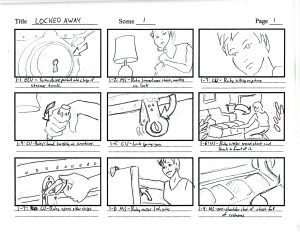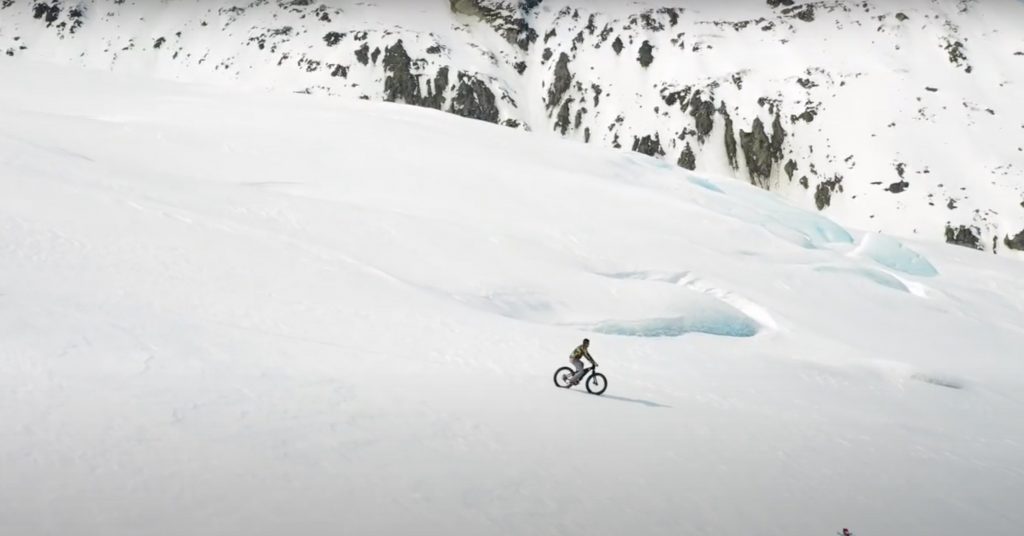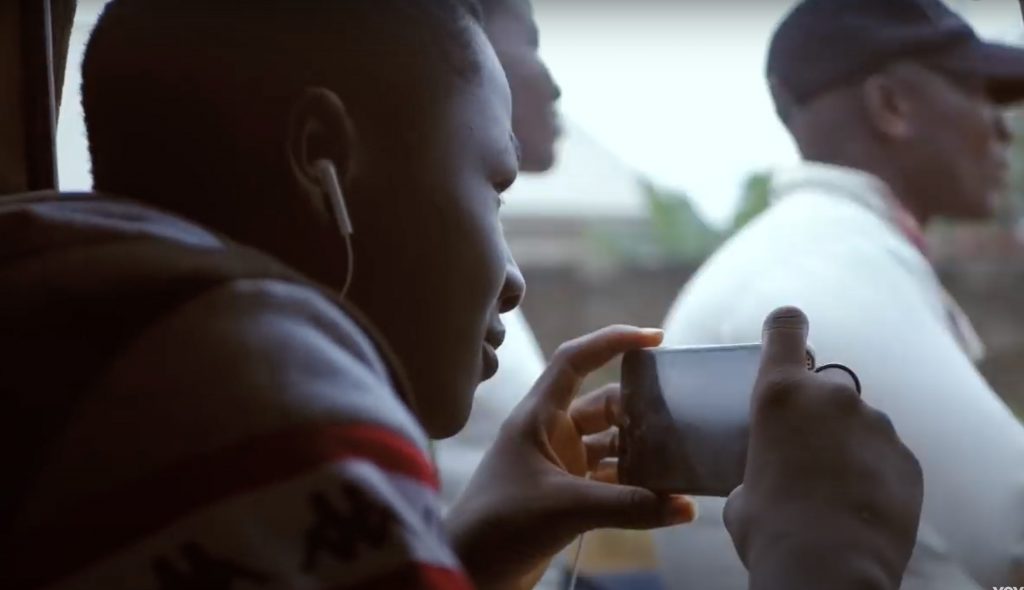Most great films have one thing in common: they’re experiments that push the limits. There’s the shower scene in “Psycho.” There’s the outrageously mismatched leads in “King Kong.” And the dead narrator in “Sunset Boulevard.” For a current example, consider “Locked Away” directed by Chicago filmmaker David Schmidt. Here the challenge was making a slick-looking movie using found resources and almost no gear. The director shares his ideas about minimalist filmmaking in an interview (below).
Interview with David Schmidt
MobileMovieMaking: What made you want to become a filmmaker?
Schmidt: I was initially interested in fiction writing and art, but the double-punch of “Star Wars” and “Alien” opened my eyes to creating worlds in cinema. After a couple of failed feature attempts post film school, I went off and did a lot of theater including stage combat and Renaissance faire. Sword & Cloak Productions started as a theater company, but everything I was writing kept turning into screenplays, so I went back to my first love. The sword represents “action” and the cloak “mystery.”
MobileMovieMaking: How did you develop your filmmaking skills?
Schmidt: I went to film school, but I don’t feel like I really started to hone my craft until I started teaching myself from the ground up. I did Public Access TV to get my hands on equipment, learning all the different skills such as camera, lighting, and audio. And the DSLR revolution pushed that even further. Being able to grab a camera or phone and just practice shooting is huge. I think the “phone generation” of filmmakers is going to bring us a new wave of filmmaking.
MobileMovieMaking: On YouTube you call “Locked Away” a “test project.” Could you explain what that is?
Schmidt: The first time I shot and edited a short on my phone, I was struck by the amazing potential. If this had happened when I was 15 years old, it would have changed my path. I started teaching a Mobile Phone Filmmaking class at an art center in my neighborhood to encourage people to use the technology to tell their own stories. Lots of filmmakers, including myself, are fond of saying “It’s not the equipment.” With “Locked Away,”I wanted to show the students how much you could do with minimal resources. It was a test for me to see what I could do working without gimbals, sliders, or other tech-tools. It’s really about composition and performance.
MobileMovieMaking: So did you use any gear beside the camera?
Schmidt: Just a few basic items: an inexpensive Movo on-camera mic., a cheap thrift-store photo tripod, and a simple Neewer 308 LED light, a scoop light, and a reflector. I also used a cheap prism and a magnifying lens for the distorted shots . That was an idea I’ve wanted to test for a while.
MobileMovieMaking: How did you come up with the idea for “Locked Away”?
Schmidt: It’s completely resource-driven filmmaking. I looked at what I had around the house and wrote accordingly. I love the metaphorical nature of working in the horror genre, and who doesn’t enjoy good spooky story?
MobileMovieMaking: How did you plan the shoot?
Schmidt: I’m a pretty rigorous planner. While’s it’s OK to be open to opportunity on the shoot-day, if inspiration fails you gotta have a plan. A good plan saves time and money, and lets you work efficiently.
For the class, I wanted to be able to give them copies of the script, the shot list, and the storyboards so they could see each step of the process before watching the completed film.
MobileMovieMaking: Props play a big role in your movie. How did you find them?
Schmidt: That chest has been our coffee-table for over 20 years. It was already full of old Ren Faire costumes. I picked up the Doll—Loralie—at a thrift store years back for another project that never happened. So she’s just been waiting for her chance to star in a movie.
MobileMovieMaking: Speaking of stars, your actress gives a compelling performance.
Schmidt: Kate Black-Spence is a remarkable actor, who deserves far more fame. She was recommended by a theater friend for a previous project “House of Nightmare Lane,” and was a delight. I’m so glad she agreed to collaborate on this short!
MobileMovieMaking: Why did you decide to shoot with a phone rather than a traditional camera?
Schmidt: I wanted to see what I could accomplish with it. I expected it would be light and fast, but I was surprised at how brisk and efficient shooting was! I was using an older phone—a Samsung Galaxy S6. The free App Open Camera worked well most of the time, but focus was an issue a few times. FilmicPro is definitely worth the money to get greater manual control and the focus and exposure tools.
MobileMovieMaking: Any other gear?
Schmidt: I recorded back-up audio with a Tascam DR-40, but I never used it. Kate has a strong, stage-trained voice, and shooting all the dialogue in close-ups worked just fine.
MobileMovieMaking: Although your story is simple, there are some challenges for the actor. As a director, what did you do to make these moments work?
Schmidt: Kate and I sat down in advance and talked about character and context, and how best to approach it. We talked about what the character might wear and so on. Then it was really just a matter of tweaking during the actual shoot: scaling the performance, emphasizing certain gestures. The key is being ready to help the actor if needed. Take the phone conversation. The actor has to imagine what the other person is saying and respond to it. If they’re having problems making it seem natural, I’m happy to have someone else play the other voice, and edit it out later. But Kate is seasoned, so she did it herself and makes it look effortless.
MobileMovieMaking: How long did the shoot take?
Schmidt: About three hours. It was wonderfully smooth. I try to test out camera angles and lighting before the shoot. I hate wasting time and having actors standing around. Originally I had planned to shoot the first scene from the opposite side, but the lighting and background were better flipped 160 degrees from what’s in the storyboards.
MobileMovieMaking: Did you encounter any problems?
Schmidt: We started to run out of battery life on the phone toward the end of the day. I definitely recommend having a portable USB charger as a back-up. In this case, I reduced the number of takes. And I did a few of the shots of the doll as pick-ups later, without Kate. That’s not even her leg in most of them. That gave me room to play around with using the prism and other distorting lens on my own time, with no pressure. With experience, you learn what’s worth getting on the day, and what you can easily pick up later.
MobileMovieMaking: What about the editing?
Schmidt: I edited on Final Cut Pro X. But it’s basic cuts. It could have been edited on iMovie, or KineMaster, or what-have-you. Roger Corman always said “Engage the eye first”, and if you don’t have a lot of movement, then get lots coverage. With somebody talking, it’s good to have relevant details to cut to, keeping up the interest and energy. My best advice on editing is “be ruthless”. It’s good to know when to linger on the moment an actor is giving you, but the audience absorbs things pretty fast. On the fine-edits, I cut everything I think I possibly can. And then I do another run, and cut even more! Try removing anything, just to see if the scene really needs it – you can always go back to the previous edit. But I almost never do. Boring is the worst sin. It’s always better to have a shorter film that people want more of, than a movie that lags in the middle or overstays it’s welcome.
MobileMovieMaking: And the audio?
Schmidt: Since the lighting wasn’t very moody, I thought a lot of the atmosphere was going to come from the audio. It was fun to experiment with little breaths and vocalizations. Using distortion or running things backwards. A talented old friend, Brenda Holiday, came over and recorded with me. Her wicked laugh at the end is really perfect!
MobileMovieMaking: What advice do you have for someone just starting out making movies?
Schmidt: Don’t let what you *don’t* have stop you from making movies. High quality tools are great and can give you more options. But they don’t replace good storytelling. And not having them is no excuse not to get out there and start making your movies.You don’t need a big budget to have good storytelling. Writing good script costs almost nothing. Good composition costs nothing. Effective lighting doesn’t have to be complicated lighting. And that thing everybody says about how audio is more important than video? It’s true. Make your movies. Learn from them. Make some more. And have fun!
# # #
You can learn more about David Schmidt’s work on the Sword and Cloak Facebook page, on YouTube, and on his website.
# # #
The editors of MobileMovieMaking have chosen “Locked Away” as the Mobile Movie of the Week.




 Previous post
Previous post
 Next post
Next post






Inspirational – even for an old dog.